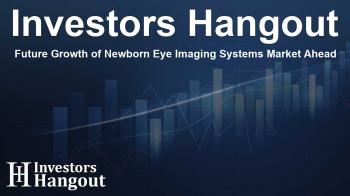Future Growth of Newborn Eye Imaging Systems Market Ahead

Exploring the Expanding Market for Newborn Eye Imaging Systems
The global newborn eye imaging systems market is becoming a significant area of focus for healthcare innovations, with a projected valuation of US$ 3.09 billion by 2033. This anticipated growth translates into a compound annual growth rate (CAGR) of 5.81% from recent estimates. Such a market expansion not only signifies a leap in economic value but highlights the pressing need for enhanced medical technologies to support neonatal healthcare.
Annually, about 15 million preterm infants make their entrance into the world, with nearly 12% requiring intensive care in neonatal units. The challenges faced by these vulnerable populations, such as intermittent hypoxia and systemic instability, increase the urgency for effective imaging solutions that can help in identifying ophthalmic complications early on. As a response, healthcare professionals are turning towards high-resolution cameras specifically designed to assess fragile eyes without the need for direct contact.
Key Drivers of Growth in Newborn Eye Imaging
The surge in the newborn eye imaging systems market can be largely attributed to several catalytic factors. Retinopathy of prematurity (ROP) remains a central focus, being a leading cause of visual impairment in children. The World Health Organization estimates that ROP is responsible for approximately 50,000 childhood blindness cases each year. Screening recommendations from numerous countries emphasize the need for thorough evaluations during early weeks of life, making advanced imaging technologies indispensable.
The Role of Technological Innovation
Recent advancements in imaging technology are reshaping the landscape of neonatal eye care. For instance, the utilization of wide-field digital imaging has demonstrated significant improvements in identifying eye diseases compared to traditional methods. Reports from recent medical meetings show that the introduction of ultra-wide-field cameras resulted in a 28% reduction in missed diagnoses of serious conditions.
Broader Clinical Applications for Ocular Imaging
As clinicians look beyond ROP, the applications of neonatal ocular imaging are diversifying to diagnose congenital cataracts, neonatal herpes simplex keratitis, and other complex conditions. This shift is crucial because timely diagnosis can lead to better surgical outcomes and overall visual health in infants. Furthermore, imaging technologies are increasingly being integrated into other vital health assessments, enhancing the overall care framework.
Challenges Impacting Adoption
Despite the promising advancements, several challenges remain within the newborn eye imaging systems market. High initial investment costs for advanced imaging devices can limit their accessibility, especially in lower-resource areas. Additionally, there is a pressing need for trained neonatal ophthalmologists, which poses a significant barrier to effectively managing ROP and other ocular disorders.
Regional Insights: Growth Opportunities Across Geographies
The market dynamics present different opportunities across regions. The Asia-Pacific area, in particular, is experiencing significant growth, driven by high birth rates and expanding NICU facilities. Countries like India and China are actively introducing initiatives aimed at equipping healthcare facilities with cutting-edge imaging technologies that can help reduce the incidence of eye diseases in newborns.
On the other hand, regions such as the Middle East are not to be overlooked, where government-driven health agendas are pushing for the integration of new technologies into existing healthcare frameworks, enhancing overall care delivery.
Competitive Landscape and Future Trends
As the market evolves, competition will intensify among established ophthalmic companies and innovative startups. Partnerships aimed at developing advanced imaging solutions are becoming more prevalent, with notable collaborations emerging from top firms. Research and development efforts are likely to shift from solely improving product features to enhancing the service model, focusing on after-sales support and user training to ensure optimal usage of the imaging devices.
Frequently Asked Questions
What is the growth expectation for the newborn eye imaging systems market?
The market is expected to reach a valuation of US$ 3.09 billion by 2033, growing at a CAGR of 5.81%.
What role does ROP play in this market?
ROP is a significant driver of growth in the market as it is the leading cause of childhood blindness, prompting increased demand for early diagnosis technologies.
How are technological advancements impacting the market?
Advancements in imaging technologies are improving diagnostic accuracy and accessibility, thus transforming neonatal eye care practices.
What challenges does the market face?
Key challenges include high costs associated with advanced technologies and a shortage of trained healthcare professionals to operate these systems.
Which regions are seeing significant growth in market demand?
The Asia-Pacific region is notably seeing growth due to high birth rates and governmental initiatives aimed at improving neonatal care.
About The Author
Contact Henry Turner privately here. Or send an email with ATTN: Henry Turner as the subject to contact@investorshangout.com.
About Investors Hangout
Investors Hangout is a leading online stock forum for financial discussion and learning, offering a wide range of free tools and resources. It draws in traders of all levels, who exchange market knowledge, investigate trading tactics, and keep an eye on industry developments in real time. Featuring financial articles, stock message boards, quotes, charts, company profiles, and live news updates. Through cooperative learning and a wealth of informational resources, it helps users from novices creating their first portfolios to experts honing their techniques. Join Investors Hangout today: https://investorshangout.com/
The content of this article is based on factual, publicly available information and does not represent legal, financial, or investment advice. Investors Hangout does not offer financial advice, and the author is not a licensed financial advisor. Consult a qualified advisor before making any financial or investment decisions based on this article. This article should not be considered advice to purchase, sell, or hold any securities or other investments. If any of the material provided here is inaccurate, please contact us for corrections.

